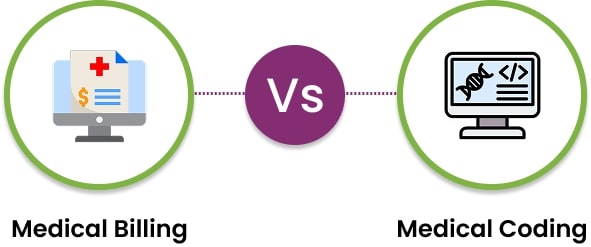Chronic pain affects more than 50 million adults in the United States, influencing approximately 1 in 5 people. With such high prevalence, the demand for specialized pain care is increasing, and so is the need for accurate pain management billing. In response, CMS introduced new billing codes like G3002 in 2023 to streamline reimbursement for chronic pain services.
Through pain management billing services, billers convert clinical pain-relief procedures, such as injections, nerve blocks, and dry needling, into standardized CPT and ICD‑10 codes. Once the coding is done, bills are submitted to insurance for reimbursement.
It plays a critical role in helping pain practitioners secure timely payment and maintain regulatory compliance, especially as CMS requirements become more stringent. Read till the end to inform yourself about all the details of pain management coding and billing.
Table of Contents
ToggleWhat is Pain Management Billing?
Pain management billing refers to the systematic process of recording, coding, and submitting healthcare claims for services provided to patients dealing with acute or chronic pain. This includes documenting procedures, such as epidural injections, nerve ablations, and physical therapies.
The goal is to accurately translate these clinical services into recognized billing codes, such as CPT, HCPCS, and ICD-10. With this process, billers facilitate appropriate reimbursement from private insurers, Medicare, or Medicaid. It supports the financial health of pain management practices and ensures compliance with federal regulations.
What Is Chronic Pain Management Billing?
Chronic pain management billing targets long-term pain that has been persistent for over 3 months. CMS defines chronic pain as “persistent or recurrent pain lasting more than 3 months” and allows providers to bill regardless of prior diagnosis history, as long as documentation supports these procedures.

These codes enable reimbursement for medication review, pain assessments, crisis planning, and more, provided the time thresholds are met and documented.
What Are Common Billing Errors in Pain Management?
Errors while providing pain management billing services can cost pain practices thousands. Common mistakes include:
- Using Wrong or Outdated Codes: Selecting an incorrect CPT/ICD code for a procedure, such as coding a nerve block incorrectly, leads to claim denials.
- Missing or Incorrect Modifiers: Forgetting required modifiers like modifier 50 for bilateral procedures or using the wrong one can change payment amounts.
- Inadequate Documentation: Failure to include full procedure details (site, laterality, technique) and medical necessity in the chart will trigger denials.
- Ignoring Payer Rules: Treating all insurers the same, including applying Medicare guidelines universally, often causes errors. For instance, some payers cover acupuncture only under specific conditions.
- Authorization and Bundling Mistakes: Not obtaining required pre-authorizations (especially for injections) or improperly unbundling services will result in denials.
- Duplicate Billing or Unbundling: Billing overlapping services separately when not allowed, such as billing an epidural and a facet block concurrently, invites audits.
Can Doctors Who Handle Pain Management Billing Also Prescribe Medication?
Yes, physicians and qualified providers who handle pain management billing are also fully authorized to prescribe pain medications. Managing billing does not limit a doctor’s prescribing authority, as it is just an additional factor.
However, providers must follow strict regulations when prescribing opioids or other therapies. In practice, specialists routinely document their prescriptions in the medical record to support both patient care and pain management billing.
What Is the Difference Between Billing and Coding in Pain Management?
Accurate billing (claim submission and revenue collection) and CPT coding (assigning procedure and diagnosis codes) are distinct but linked tasks. Below is a summary comparison:
| Aspect | Pain Management Billing | Pain Management Coding |
|---|---|---|
| Definition | Submitting claims and collecting payments for pain-related services. | Selecting CPT/ICD codes that describe pain treatments, such as injections. |
| Purpose | Ensure correct reimbursement and cash flow for the practice. | Accurately represent clinical services in data and claims. |
| Tasks | Charge entry, claim submission, payer follow-up, denial appeals, payment posting. | Reviewing documentation, assigning procedure codes, and adding modifiers. |
| Outcome | Paid claims, revenue, and financial reports. | Coded patient encounter records and justification for billing. |
How Does Pain Management Billing Differ From CPT Coding?
CPT coding involves identifying precise codes, such as 20561 for dry needling and 64490 for facet injections. However, billing involves using these codes to file claims, negotiate with payers, appeal denials, and collect payment.

While CPT coding is clinical and documentation-driven, billing is administrative and financial. Both need seamless integration, as correct codes with compliant documentation support billing for revenue capture.
What Is the Difference Between Pain Management Billing and a Flat Bill?
To know the difference between medical billing for pain management and a flat bill, go through the points below.
Pain Management Billing: Uses specific CPT/ICD codes for each procedure, including nerve block and stimulator implant. It itemizes services so reimbursement matches the care rendered. This approach maximizes accuracy and compliance with payer rules.
Flat Billing: Charges a fixed fee with a bundled monthly rate regardless of individual services. While simpler, flat fees often underestimate actual costs or violate payer requirements that demand detailed coding. Flat billing may simplify patient billing, but it risks underpayment and is rarely acceptable for insurance claims.

What Are Pain Management Billing Codes?
Pain management billing services use diverse code sets:
- CPT for procedures, including nerve blocks and dry needling
- HCPCS for care bundles, especially for chronic pain management
- ICD‑10 for diagnoses
- Modifiers for procedure specifics
These serve different billing needs, such as bundle codes for chronic care, procedural CPTs for injections, and ICD‑10s for diagnostic justification. Their details will be covered in the next parts of this article, so keep on reading.
What Are the Categories of Pain Management Billing Codes?
As mentioned, pain management billing codes fall under the CPT coding system, which is maintained by the AMA. They are divided into three main categories, as explained below:
Category I CPT Codes
These are the standardized codes used to describe widely accepted medical procedures, including the majority of pain management interventions.
20552 – Injections, single or multiple trigger points, 1 or 2 muscles
64483 – Injection(s), anesthetic agent and/or steroid; transforaminal epidural, lumbar or sacral
63650 – Percutaneous implantation of neurostimulator electrode array
Most interventional pain procedures and office visits fall under this category.
Category II CPT Codes
Such codes are supplemental tracking codes used for quality improvement rather than billing. They help providers and payers track performance measures like pain assessment, but do not affect reimbursement directly.
G8907 – Pain severity quantified, pain considered uncontrolled
As optional codes, they support compliance with CMS quality initiatives like MIPS.
Category III CPT Codes
These temporary codes prove valuable for emerging procedures or technologies not yet widely adopted. A Pain management billing company may apply these codes to newer treatments, such as advanced neuromodulation techniques.
0338T – High-frequency spinal cord stimulation, trial
0275T – Injection or infusion for chemodenervation of paravertebral muscles
These codes may eventually convert to Category I if they gain broader clinical acceptance.
Why Accurate Pain Management Coding Matters?
Benefits of accurate pain management coding include:
- Helps practitioners get full reimbursement.
- Reduces claim denials.
- Minimizes audit risk by complying with CMS guidelines.
- Improves data quality for patient care and reporting.
What Are CPT Codes For Pain Management?
The following are some of the most commonly used CPT codes in pain management billing:

What Are CPT Codes for Chronic Pain Management (CPM)?
As chronic pain becomes a growing public health concern, CMS has introduced specific codes. These codes reflect the ongoing care that patients with chronic pain often require.
G3002 – first 30 min of chronic pain management per month
G3003 – add-on for each additional 15 min beyond G3002
Time must be documented cumulatively by physicians for pain management coding.
What Are CPT Codes for Complex Care Management (CCM)?
These codes cover non-face-to-face time spent managing a patient’s health. Moreover, they prove to be especially valuable in multidisciplinary pain management practices.
99490 – first 20 minutes of provider-directed clinical staff time spent on CCM
99487 – first 60 minutes of non-face-to-face care provided by clinical staff
99489 – additional 30 minutes of non-face-to-face, CCM services provided by clinical staff
What Are the CPT Codes for Abdominal Plane Blocks?
New CPT codes, such as 64488 and 64489, now describe ultrasound-guided abdominal plane blocks. Additionally, these codes cover TAP blocks and similar fascial plane injections used in pain interventions.
Apart from that, thoracic and lower-extremity plane blocks have analogous codes. For example, CPT 64466 for unilateral thoracic fascial plane block, which should be paired with appropriate ICD-10 pain diagnoses.

What Are the Most Frequently Used CPT Codes in Pain Management?
Pain practices frequently use CPT codes for injections and procedures, including:
20560 to 20561 – trigger point injections
64490 to 64495 – facet joint injections
62310 to 62313, 62318 to 62319 – epidural injections
64400 to 64530 – range nerve blocks
20610, 20611 – joint injections
99211 to 99215 – pain medicine management visits
What Is CPT Code 20561?
This code is used for dry-needling procedures involving needle insertions without injection into three or more muscles. It includes the cost of needles and supplies and is untimed, as one unit covers the entire treatment session.
For example, if a therapist inserts needles into trigger points in three different muscles, report 20561. Accurate documentation, such as listing each muscle treated, supports the use of this code.
What Is the CPT Code for Dry Needling?
There are two CPT codes for pain management billing used to bill for this procedure:
20560 – used when dry needling is performed on 1 or 2 muscles.
20561 – applies when the treatment involves three or more muscles.
Both codes refer specifically to needle insertion without any injection. Moreover, they help ensure providers are accurately reimbursed for the scope of the procedure.
What Are ICD Codes for Pain Management?
Some of the most commonly used ICD-10 codes used by pain management billing companies include the following.

G89.21 – Chronic pain due to trauma
G89.28 – Other chronic postprocedural pain
G89.29 – Other chronic pain
G89.4 – Chronic pain syndrome
G90.511 – Complex regional pain syndrome I on the upper right limb
G90.512 – Complex regional pain syndrome I on the upper left limb
What Is the ICD-10 Code for Lumbar Facet Arthropathy?
M46.96 is the ICD-10 code used when a doctor diagnoses inflammation in the lower back without a specific cause being identified. Linked to facet arthropathy, the small joints in the spine may be worn down, causing pain.
What Is the ICD-10 Code for Lumbar Facet Syndrome?
Pain management billing services providers use code M46.96 for lumbar facet syndrome, which refers to inflammation in the facet joints of the lower back. Such a code applies when the medical records mention terms like “facet arthropathy” or “facet joint pain.”
What Is the ICD-10 Code for Cervical Facet Syndrome?
Most of the pain management billing companies write the M53.82 code to describe Cervical Facet Syndrome. Falling under the category of “Other specified dorsopathies, cervical region”, it covers spinal disorders in the neck area.
What Is the ICD-10 Code M47.816?
ICD-10 code M47.816 refers to spondylosis without myelopathy or radiculopathy, lumbar region. With this code, pain management billing companies can describe age-related degeneration of the spine in the lower back without nerve involvement.
What Are the Codes for Thoracic and Lower Extremity Fascial Plane Blocks?
When billing for these procedures, use the following CPT and ICD-10 codes to maximize reimbursement chances and improve clinical documentation.
64490 – Injection(s), diagnostic or therapeutic agent, paravertebral facet joint nerve(s)
64486 – Injection, anesthetic agent; transversus abdominis plane (TAP) block, unilateral
64488 – Injection, anterior quadratus lumborum block, unilateral
64489 – Injection, lumbar plexus block, posterior approach
M54.6 – Pain in thoracic spine
M54.5 – Low back pain
G89.29 – Other chronic pain
G57.10 – Lumbosacral plexus disorder, unspecified side
What Is the Process of Pain Management Billing?
Overall, the pain management billing process ensures each service is documented, coded, submitted, and paid correctly. Some of its main sub-processes involve the following:

How Is Pain Management Billed to Insurance Providers?
Pain management billing companies follow the steps below to bill insurance providers.
- Verify Coverage: Before a visit, confirm patient insurance and benefits (covered services, pre-authorization requirements)
- Document Service: After each encounter, ensure a detailed note is written, including diagnosis, treatment, procedures with laterality, and medications given.
- Code the Encounter: Assign the correct CPT-ICD code pair and modifiers based on the note. Always use medical necessity to justify interventions.
- Submit Claim: Enter charges and codes into your practice management system. Submit the claim electronically or via CMS 1500/UB-04 forms to the payer.
- Follow-Up: Never forget to monitor claim status while doing pain management billing. If denied or unpaid, review denial reasons and file appeals when needed.
- Collect Payment: Once approved, post insurer payments. Balance-bill patients for any remaining amount, including co-pays and deductibles.
- Patient Billing: Finally, pain management billers generate statements and follow up on patient payments or outstanding balances.

How Is Revenue Cycle Management Handled in Pain Management Practices?
RCM covers the full lifecycle of a patient encounter, from scheduling to final payment. Key phases include:
1. Pre-Registration and Eligibility: During this initial step, pain management billing companies collect patient information and insurance details.
2. Charge Capture and Coding: After that, the billing team accurately records all services provided with appropriate codes.
3. Claim Submission: Once you have correctly matched CPT and ICD codes, send claims to payers.
4. Denial Management: If you encounter rejection, identify denied claims and take corrective action, such as modifying and resubmitting claims.
5. Payment Posting: Upon managing the denials one by one, apply payments from insurers and patients to the accounts.
6. Follow-Up: Keep an eye on each submitted claim and pursue overdue payments from payers or patients.
Optimizing RCM in pain practices often means outsourcing to experts. Partnering with a specialty pain management billing firm, such as Transcure, can improve cash flow by reducing errors and speeding reimbursements.
What are Pain Management Billing Guidelines?
A pain management billing company must follow laws, documentation standards, payer rules, and best practices. Go through these guidelines to improve pain billing services.
What Are the Billing Laws Related to Pain Management?
Some of the most important laws overseeing the pain management billing are as follows:
- False Claims Act: prohibits fraudulent billing or upcoding
- Stark & Anti-Kickback: prohibits inappropriate financial relationships
- HIPAA Privacy: protects patient information
- FDA, DEA, CDC Regulations: govern controlled substance prescribing
Violations of these laws can result in audits, fines, or practice sanctions.
What Documentation Is Needed for Accurate Pain Management Billing?
To optimize pain management billing, make sure to document these processes.
- Diagnostic justification, including symptoms, duration, exam, and imaging
- Procedure details, such as site, laterality, and technique
- Time logs for time‑based codes
- Validated pain assessment tools
- Care plan notes, medication details, crisis interventions
- Informed consent for procedures
Is Pain Management Covered by Medicare?
Yes, Medicare covers many pain services if documented and medically necessary. Practitioners will get paid for the following procedures:
- HCPCS G3002/G3003 for chronic pain management (monthly bundles)
- Facet joint and epidural injections with appropriate documentation
- Dry needling (20560 and 20561) for myofascial trigger points, under certain Medicare contractor LCDs
- Acupuncture is only for chronic low back pain (more than 12 weeks), otherwise, it requires a patient waiver
What Are the Types of Pain Management?
Healthcare professionals can bill for the following types of pain management.
- Interventional: injections, nerve blocks, epidurals, neuromodulation
- Conservative: medication management, physical therapy, dry needling, acupuncture
- Bundled: chronic pain management services (coordination, counseling)

Which Is the Best Billing Company for Pain Management?
Transcure is a recognized leader in medical billing, including pain management. Their team includes coders certified in pain and neuromodulation for maximizing collections. Its use of RPA automation and pain-specialist coders ensures high accuracy and faster collections.
They report over 99% clean claim rate and faster cycle times. Practices seeking reliable pain management billing support should consider Transcure for its proven results.
How to Choose the Best Billing Company for Pain Management?
Look for these four key qualities while choosing the best pain management billing company for your practice:
- Specialty Expertise: The company should have deep experience in pain management billing, like knowing CPT codes for injections, stimulators, and more. Their staff should stay current on pain-related coding changes.
- Regulatory Knowledge: A billing company must stay up-to-date with the latest CPT/ICD and CMS regulations. Verify that they track CMS updates, including new HCPCS G-codes, to avoid compliance issues.
- Technology and Accuracy: Prefer firms using advanced tools to reduce errors. For example, Transcure reports using RPA bots to achieve over 99% claim accuracy and faster billing cycles.
- Security and Certifications: Ensure the pain management billing vendor is HIPAA-compliant and ideally certified for ISO 27001 and SOC 2. These certifications indicate they follow stringent privacy and security standards.
A good pain billing partner, such as Transcure, will provide transparent reporting and a proven track record of high collections.
Conclusion
All in all, pain management billing is a complex but critical part of a pain practice’s financial health. It requires up-to-date knowledge of CPT/ICD codes, CMS rules, and thorough documentation. By avoiding common errors and following CMS guidelines, providers maximize legitimate revenue and compliance.
Partnering with experts like Transcure can further streamline billing. With careful coding, diligent billing processes, and a focus on regulatory compliance, pain practices can improve cash flow and focus on patient care.
Frequently Asked Questions (FAQs)
Why is pain management billing complex?
Billing for pain management is complex due to the variety of procedures and frequent changes in CPT and ICD-10 codes. Other than that, payer-specific requirements, prior authorization needs, and the necessity for detailed documentation are needed to avoid claim denials.
What are the benefits of outsourcing pain management billing?
Outsourcing reduces administrative burdens, lowers operational costs, and improves cash flow by up to 20-25 percent. Experts at pain management billing companies speed up payments and allow providers to focus more on patient care rather than billing complexities.
How can technology improve the pain management billing process?
Using specialized billing software and EHR integration tailored for pain management improves coding accuracy and claim tracking. Such technological tools also improve eligibility verification and reporting, leading to faster reimbursements.










